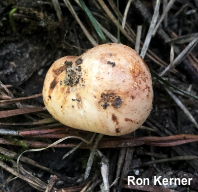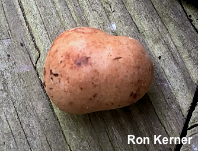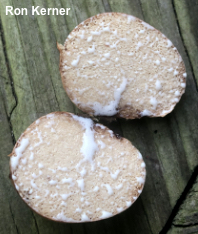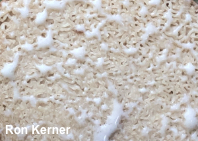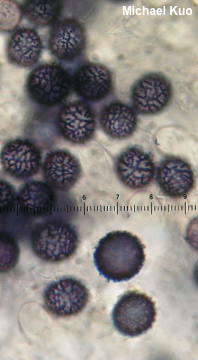| Major Groups > Oddballs & Misfits > Zelleromyces cinnabarinus |
| Major Groups > Gilled Mushrooms > Pale-Spored > Lactarius > Zelleromyces cinnabarinus |

|
Zelleromyces cinnabarinus [ Basidiomycota > Russulales > Russulaceae > (Zelleromyces) Lactarius . . . ] by Michael Kuo Found under pines in the southern United States, Zelleromyces cinnabarinus looks like a puffball until you slice it open. It has a "loculate" interior, composed of tightly packed "locules"—the term in Mycologese for cavities formed by the spore-producing surfaces of truffles and false truffles. If you cook a bunch of spaghetti, pack it as tightly as possible into a balloon, freeze your masterpiece, and then slice it in half with the world's sharpest razor blade so that the individual spaghetti noodles get cross-sectioned, you will approximate "loculate." But with Zelleromyces cinnabarinus you will also be in for a surprise when you slice a young fruiting body open, because the mushroom will produce milk like a species of Lactarius—a "milky cap." And in fact this funky mushroom is a milky cap, or a "milky ball" (just move along); it represents a sequestrate form of Lactarius that does not produce a cap, stem, and gills. Thanks to Ron Kerner for documenting, collecting, and preserving Zelleromyces cinnabarinus for study; his collection is deposited in The Herbarium of Michael Kuo. Description: Ecology: Mycorrhizal with pines (species of Pinus, with bundled needles); growing along or gregariously; summer and fall; distributed from Mexico and Texas to the Carolinas, Illinois, and Indiana. The illustrated and described collection is from Indiana. Fruiting Body: 1–3 cm across; shaped more or less like a ball or a rounded cushion; sometimes fused with other fruiting bodies and appearing lobed; pinched at the base, sometimes (especially when young) attached to a tiny basal stub; outer surface bald or a little felty, dry, whitish to orangish at first, maturing to dull cinnamon orange or brownish orange; interior loculate (see above), packed more tightly toward the base, whitish when young, becoming orangish to brownish. Milk: White and abundant in young fruiting bodies; later more scant and watery; not staining tissues. Odor and Taste: Not distinctive. Spore Print: Not obtainable. Microscopic Features: Spores 10–14 µm (excluding ornamentation); globose to subglobose; ornamented with amyloid spines and ridges 0.5–1.5 µm high, forming a complete or nearly complete reticulum; ornamentation fine but dense. Basidia 1- and 2-sterigmate. Cystidia not found. Peridium surface a turf of hyphae 2–3 µm wide, smooth, hyaline; terminal cells cylindric to slightly fusiform or irregular. REFERENCES: R. Singer & A. H. Smith, 1960. (Sundberg & Trappe, 1975; Miller & Lebel, 1999; Trappe et al., 2007; Elliott & Stephenson, 2018.) Herb. Kuo 09181901. This site contains no information about the edibility or toxicity of mushrooms. |
© MushroomExpert.Com |
|
Cite this page as: Kuo, M. (2020, January). Zelleromyces cinnabarinus. Retrieved from the MushroomExpert.Com Web site: http://www.mushroomexpert.com/zelleromyces_cinnabarinus.html |
